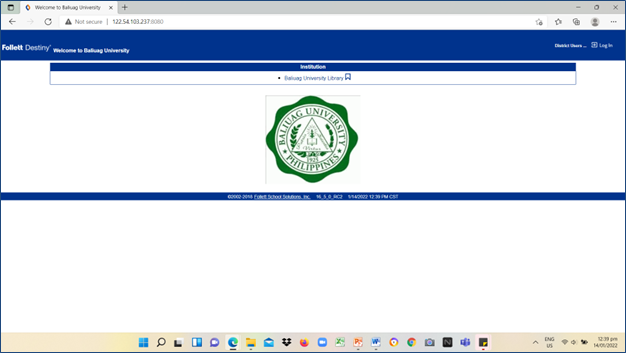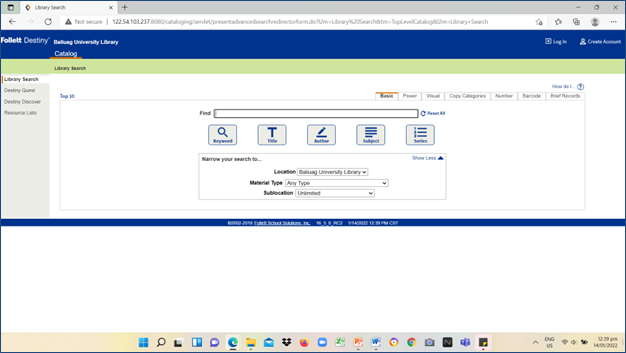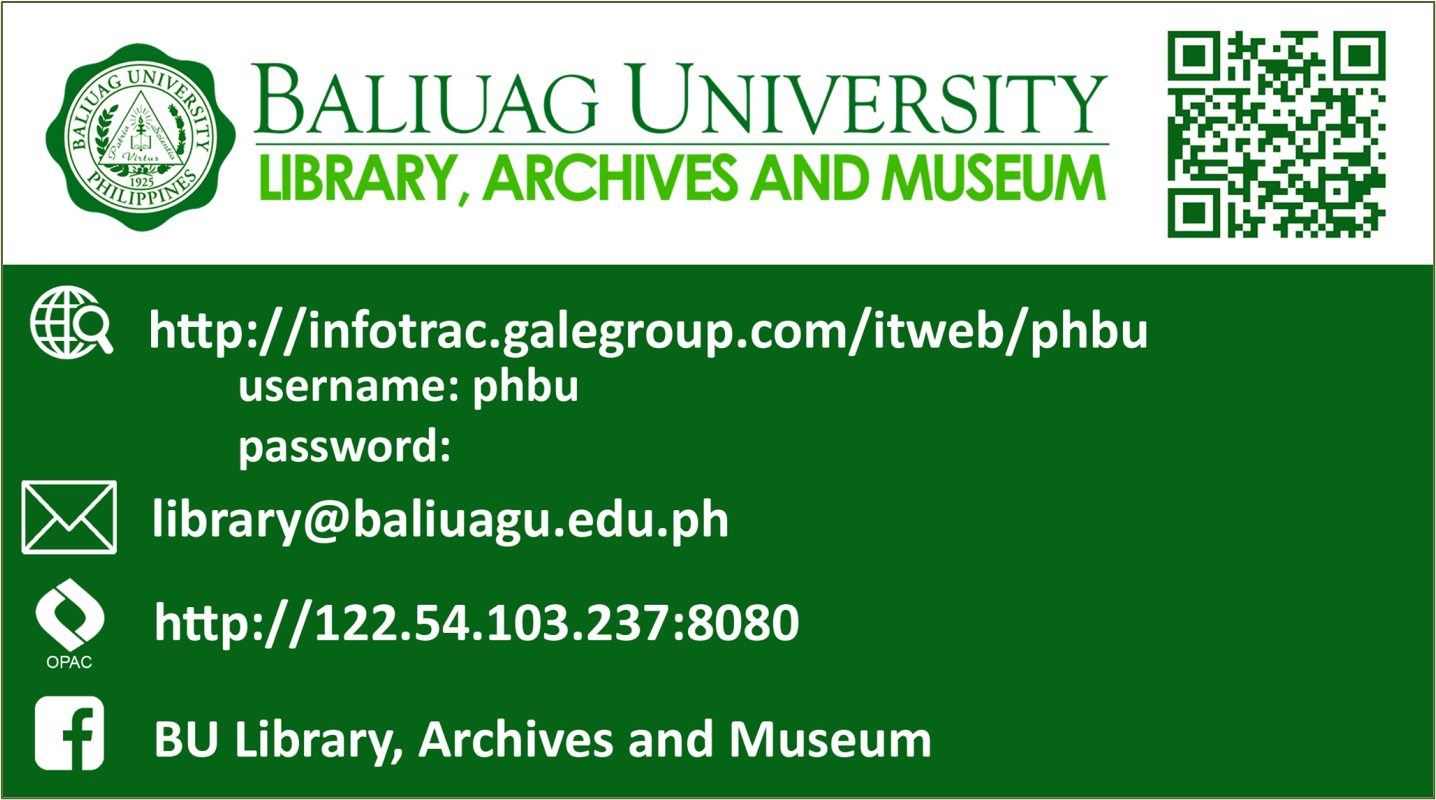

MISSION, VISION, GOALS, AND OBJECTIVES
Mission
The Baliuag University Library, Archives and Museum (BULAM) participates in the research and education program of the university by selecting, organizing, preserving, and conserving books and other materials of contemporary interest and value for the education and intellectual stimulation of the entire students, faculty and administrative staff, and to provide easy access to the collections through retrieval tools and appropriate information services.
Vision
The Baliuag University Library, Archives and Museum’s librarians and information professionals find new ways of developing effective and collaborative partnerships with the faculty, students, and administrative staff to be able to meet their diverse informational, research, educational and recreational needs.
Goals
1. To provide materials and information services which are responsive to the needs of the academic and non-academic community and ensure their maximum accessibility and expeditious delivery.
2. To provide pleasant, safe, accessible, and well-maintained building and facilities which enhance the use of the library’s resources.
3. To develop and maintain an effective staff committed to the provision of quality service.
4. To facilitate public access to library collection and services and improve the efficiency of library operations through the appropriate application of automated systems for information retrieval, management, and support services.
Objectives
1. To develop, organize, and maintain a collection of books, journals, government documents, maps, pamphlets, pictures, photographs, newspaper clippings, computer files, machine-readable databases, videotapes, audiotapes, and other materials needed to meet the information, research, instructional, and related needs of the students, faculty and administrative staff.
2. To develop and maintain vigorous and discriminating programs for the identification, selection, and acquisition of library materials needed to fulfill the library’s major responsibilities of supporting the university’s research and instructional programs, providing for information needs, and advancement of learning.
3. To support university research and instruction programs by the preparation and dissemination of bibliographic and reference guides and appropriate information services.
4. To recruit and maintain a library staff of highly qualified individuals capable of a sustained level of high performance.
5. To perform the financial analysis and conduct the short and long-range planning essential to the determination of the financial needs of the library and to the judicious use of funds received.
6. To publicize and promote awareness and use of the library’s resources and services to students, faculty, and administrative staff through public relations programs and staff participation to campus activities.
7. To explore and implement increased means for cooperation with other libraries on a regional, national and international basis with regard to collection development programs, reference and information services, technical processes, and interlibrary lending, particularly through the adaptation of computerized systems.
8. To encourage and support all levels of the library staff, a lively interest in the pursuit of inquiry, whether practical or theoretical in scope, with a view to the constant enhancement of the library’s programs and services and the professional growth of its staff.
To achieve these objectives, the library must constantly strive for:
a. Effective administration and competent staff;
b. Adequate financial support;
c. Adequate staffing;
d. Efficient organization of library materials;
e. Efficient services to customers;
f. Clean, safe and adequate facilities;
g. Continuing staff development and training.
RESOURCES AND FACILITIES
Resources
The Baliuag University Library, Archives and Museum consists of books, serials, and non-book materials such as maps, charts, pictures, photographs, video recordings, sound recordings, compact discs and other documents and instructional aids purchased with university fund or acquired in any other manner by the university except for internally generated documents produced by the different departments of the university including library materials from gifts and grants of foundations, friends, faculty, alumni and students.
Facilities
Baliuag University Library, Archives, and Museum has the following facilities:
Public Services
Information / Learning Commons
Circulation and Reserve Section
Reference & Information Services
Maps, Vertical Files, Periodicals Section
Filipiniana Section
Multimedia Kiosk
Special Collection
University Archives and Museum
Basic Education Libraries
Senior High School Library
Senior High School Information Commons
Graduate Studies Library
Technical Services
Selection and Acquisition
Cataloging and Classification
Labeling, Repairing, and Binding
Indexing and Abstracting
Encoding
Online Databases
Gifts and Exchange
Information Commons
Information Commons is a faculty and student development center or center for out-of-the-classroom activities for teaching and learning. It constitutes a high-technology-rich environment including high-speed networks and public access computers. It provides a full range of productivity software such as MS Office, Adobe, Acrobat, Photoshop, etc. It emphasizes continuum of service: Information search and retrieval, processing and interpretation of information, and packaging, presentation, and production in any and all media. It provides near-seamless integration from the patrons’ perspective in terms of space, services resources, service desks, and staff. It is a departure from the traditional library of book-centered to client-centered. The primary emphasis of services is to meet the needs of the learners, researchers, and information workers. It also aims to offer a place for social networking, thus giving them opportunities for independent, self-sufficient meditation, research, and creativity, to meet wide variety of learning styles of the customers.
The Information Commons of Baliuag University provides the following: Information desk, Multimedia Creation Station, Multimedia Presentation Station, Internet Surfing Workstations, Newspaper Collection and Coffee Stations, plus, a couch to rest, Wi-Fi zone area for coffee drinkers, and a lanai for tired eyes. The section is located at the 1st floor of the main library building.
Circulation Section
The Circulation Section is one of the branches of the library that services the Baliuag University community. It contains the bulk of library collection intended for home reading use. It is located at the second (2nd) floor of the main library building.
Filipiniana Section
The Filipiniana Section houses a collection of publications about the Philippines written by Filipinos / non-Filipino and materials written in English or Filipino language in the form of books, periodicals, and pamphlets.
Reference Section
The Reference Section follows the open-shelf system as the way of accessing library materials. Materials found in this section are for inside use only. Books found in this section are comprised of different kinds of dictionaries, encyclopedias, directories, manuals, atlases, yearbooks, almanacs, indices, bibliographies, and non-book materials that include maps, globes, vertical files, pamphlets, leaflets & ephemeral materials. Books in this section give vital information on the field of research. The section is located at the third (3rd) floor of the main library building. A collection of maps is also located in this section.
Periodicals Section
This section holds current and back issues of selected foreign professional journals. Local professional journals can be found at the Filipiniana Section.
Multimedia Kiosk
Multimedia is media and content that utilizes a combination of different content forms. The term can be used as a noun (a medium with multiple content forms) or as an adjective describing a medium as having multiple content forms. The term is used in contrast to media which only utilizes traditional forms of printed or hand-produced general, multimedia includes a combination of text, audio, still images, animation, video, and interactivity content forms.
Multimedia is usually recorded and played, displayed, or accessed by information content processing devices, such as computerized and electronic devices, but can also be part of a live performance. Multimedia (as an adjective) also describes electronic media devices used to store and experience multimedia content. Multimedia is similar to traditional mixed media in fine art, but with a broader scope. The term "rich media" is synonymous for interactive multimedia. Hypermedia can be considered one particular multimedia application.
Reference books in digital format are located in Multimedia Kiosk under the label “Electronic Resources”. They can be accessed through the computers in the Multimedia Kiosk. Materials found in this section are interactive instructional CD-ROMs, VCDs, DVDs, diskettes, and audio cassette tapes. It has a seating capacity of eight (8) terminals in a given time.
University Archives and Museum
Archives and Museum is an organized body of records pertaining to an organization or institution. It contains natural accumulated documentary materials, generally unpublished and primarily intended to accomplish functional purposes. It is designed to serve as the custodian of Baliwag heritage and culture. It also serves as the repository of materials relevant to the study of Baliwag history and culture.
Archives and Museum undergone careful planning and management envisions to build an extensive and reputable archival and local history collections that cater to the needs of students, researchers, and scholars.
Basic Education Libraries
These are the libraries that specialize in children’s and young adults’ books and other library materials that can be used by grade school pupils and junior high school students. These two (2) separate libraries are located at the Basic Education Campus.
Senior High School Library
This satellite library houses the collection of books, journals, and computer terminals that will be useful to senior high school students, faculty of senior high school, and personnel. Books can be borrowed for one (1) week while fiction books are for one (1) month. This section is located in Annex III Campus along Gil Carlos St.
Graduate Studies Library
The Graduate Studies Library houses master’s theses and doctoral dissertations. The collection of books for the various programs under the School of Graduate Studies is housed at the Circulation, Filipiniana, and Reference Section of the Main Library.
Selection and Acquisition
The Baliuag University Library, Archives, and Museum’s main objective in selection and acquisition of books and other library materials is to ensure that the library collections meet the information needs of B.U.’s population in a timely and economical manner by using information resources generated inside and outside of the institution.
In selecting information resources, for the B.U. library, the Chief Librarian/Collection manager always considers the curricular offerings of the University, the learning needs of the students, the instructional and research needs of the faculty, and the reading interest of the administrative staff.
The Acquisitions Section is a part of the Technical Services Department of the library that handles the selection and acquisition of library materials. It is also concerned with obtaining books and other library materials for the library through purchases and gifts. It is essentially a service unit that is tasked to improve the academic life of the students through the provision of the best library materials. It is done by the Acquisitions Librarian with the assistance of the staff and the student assistants.
Cataloging and Classification
Cataloging is a subset of Bibliographic Control, a field in librarianship which deals with the organization of information. Cataloging is considered a technical service of a library which all other services are dependent upon.
The cataloging department exists for such a purpose: to organize information. If a library doesn’t have this function, the old adage of “finding a needle in a haystack” would be an understatement. In fact, the more appropriate statement would be: “finding a particular needle in a stack of needles.”
Records exist in all aspects of the universe of knowledge including those that are expressed verbally: music, arts, etc.). And it is the role of catalogers to provide some organization to this otherwise chaotic universe.
Bibliographic records produced and maintained by the Baliuag University Library, Archives and Museum is of world-class standards as evident by the MARC21 (Machine Readable Cataloging – 21st century) implementation, an act initiated and made popular by no less than the Library of Congress in the United States.
LIBRARY SERVICES under ULAP MODE
As we continue to deliver our library services under the “New Normal” brought about by the COVID-19 pandemic, rest assured that the Baliuag University Library, Archives and Museum is committed to providing you materials and information services that are responsive to the community’s educational and informational needs under the University Learning Alternative Platform (ULAP) Mode.
What services can you avail in the library under the ULAP Mode?
1. Electronic Resources
2. Reference Services
3. Web OPAC
4. Document Delivery Service (DDS)
ELECTRONIC RESOURCES
The library subscribes to the INFOTRAC Database which allows users to have access to electronic journals and e-books. INFOTRAC provides what 21st-century researchers expect: instant access to complete, up-to-date contents. It allows you to put the world’s leading journals and reference sources at your fingertips, with easy-to-use features and unique search tools enabling discovery.
To access the INFOTRAC Gale Database, kindly go to the link provided by the library and ask the librarian for the password. If you want to learn how to navigate the INFOTRAC database there is a video tutorial which you can watch in the official Baliuag University Library, Archives, and Museum Facebook Page.
e-journal link:
http://infotrac.galegroup.com/itweb/phbu

REFERENCE SERVICES
The Reference Services provide personal assistance to every library customer to be able to meet his/her information needs. Communicating with the librarians is fast and easy. You can “Ask a Librarian” by sending your messages or queries thru the official BULAM Facebook Page and BULAM e-mail ([email protected]).

WEB OPAC
Locating library material is easy by using the Web OPAC. The OPAC (Online Public Access Catalog) is a database of bibliographic records describing the holdings of the library and allows quick & easy searching by name, title & subject.
OPAC link:
https://bu-librarywebopac.follettdestiny.com


DOCUMENT DELIVERY SERVICE (DDS)
Document Delivery Service (DDS) is a library service which copies non-returnable literature required by library users, including book chapters, journal articles, and other library collections, and then e-mails or sends them to library users.
Requests may be sent through email at [email protected] with the specific information regarding the material/s being requested. The librarian will then search the Web OPAC, find the article or book chapter, scan the document/s and send it via e-mail. Documents sent by the library should not be shared or distributed as not to violate the Copyright Law.

CONTACT US
Telephone No: (044) 766-2045
Local Nos.
312 - Archives & Museum
313 - Basic Education Libraries
314 – Technical Section/Chief Librarian
315 – Information Commons
316 - Reference
319 - Filipiniana
E-mail Address: [email protected]
Follow us on Facebook: @BULibraryArchivesandMuseum